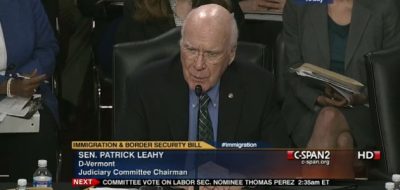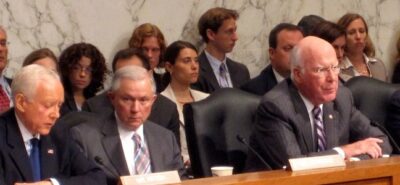Immigration Reform
The last time Congress updated our legal immigration system was November 1990, one month before the World Wide Web went online. We are long overdue for comprehensive immigration reform.
Through immigration reform, we can provide noncitizens with a system of justice that provides due process of law and a meaningful opportunity to be heard. Because it can be a contentious and wide-ranging issue, we aim to provide advocates with facts and work to move bipartisan solutions forward. Read more about topics like legalization for undocumented immigrants and border security below.
Day Two of Senate Immigration Mark-Up Continues With Temporary Employment Visas
On the second day of the Senate Judiciary Committee’s mark-up of S. 744, the “Border Security, Economic Opportunity, and Immigration Modernization Act,” the senators tackled most of the amendments to Title IV after finishing debate on a few border security amendments. The fourth section addresses the majority of non-immigrant temporary visas including those for high and less- skilled immigrant workers, entrepreneurship and innovation programs, as well as a range of miscellaneous visitor visas. Read More

Facts About H-1B Workers and the Innovation Economy
While widespread research documents a critical need for skilled workers in the United States to maintain and strengthen our innovation industry, myths exist in opposition to programs designed to help alleviate that shortage. In particular, the H-1B visa program for high-skilled foreign-born workers, primarily used for science, technology, engineering, and mathematics (STEM) fields, is a routine recipient of critical ire. As the Senate Judiciary Committee discusses H-1B reforms in Title IV of S.744, here we dispel some of the common myths associated with the H-1B high-skilled visa program. Read More

What Do You Think About Immigration Reform?
As the Senate continues to shepherd a comprehensive immigration reform bill through the legislative process (day two of mark-up in the Senate Judiciary Committee begins tomorrow), it becomes clear how many issues are at stake in reform and how interconnected they are. It’s also overwhelming at times. That’s why the American Immigration Council is attempting to divide the issues into smaller discussions on our wiki, ThinkImmigration.org. Read More

Senate Committee Mark-up Of Immigration Bill Begins With Border Security Amendments
The Senate Judiciary Committee’s mark-up of S. 744, the “Border Security, Economic Opportunity, and Immigration Modernization Act” put forward by the bipartisan Gang of 8 group of senators, began on Thursday in front of a packed hearing room and with all 18 committee members in attendance. Senators offered 32 amendments (out of the 300 filed), all relating to issues in the introduction and Title 1 of the bill. Of the amendments considered, the committee accepted 21 of them, with bipartisan support for all but one, while four were withdrawn. The primary change was to broaden the scope of the border security provisions. And as they had previously indicated, the four “Gang of Eight” members on the committee—Democratic Sens. Dick Durbin (IL) and Chuck Schumer (NY) and GOP Sens. Jeff Flake (AZ) and Lindsey Graham (SC)—voted together against any amendment that undermined the bill’s core goals. Read More

The Important Role of Immigrants in America’s Innovation Economy
This week, the U.S. Senate Committee on Commerce, Science, and Transportation weighed in on immigration reform with a hearing on the role of immigrants in America’s innovation economy. Remarks from Sens. Rockefeller (D-WV) and Thune (R-SD) noted the contributions of immigrant innovators and entrepreneurs. Immigrants in the United States were named as inventors or co-inventors on 25.6 percent of international patent applications filed from the U.S. in 2006. Furthermore, temporary workers and permanent residents made contributions to over half of the international patents filed by several large, multi-national companies. Temporary and permanent foreign-born workers represent at least 24 percent of the nation’s scientists and 47 percent of engineers with doctoral degrees. Read More

Social Security Administration Says Immigration Reform Will Increase Tax Revenue, Boost Economy
Will the immigration reform bill create millions of jobs, boost GDP, and help balance the budget? A new report by the Social Security Administration says that it will, by putting undocumented immigrants on the tax rolls and allowing them to participate fully and legally in the U.S. economy. Read More

How to Accurately Estimate the Economic Impact of the Senate Immigration Reform Bill
One of the most important questions being asked about the Senate immigration reform bill (S. 744) is how it will impact the economy. There is already a broad consensus among economic experts that immigration reform would be a net economic benefit in terms of jobs, wage levels, tax revenue, and Gross Domestic Product (GDP). As reported in Politico on May 8, for instance, a new study by the Social Security Administration estimates that “by 2024, the immigration bill will have created 3.22 million jobs, and boost GDP by 1.63 percent.” However, the most widely awaited estimate is that of the Congressional Budget Office (CBO), which will soon be “scoring” the bill in terms of its fiscal consequences. Read More

Senate Legislative Process Must Maintain Spirit of Compromise
Washington D.C. – Today, the Senate Judiciary Committee begins “mark-up” of S. 744, the Border Security, Economic Opportunity, and Immigration Modernization Act. In an unprecedented move by Senate Judiciary Committee Chairman Patrick Leahy and Ranking Member Charles Grassley, all amendments have been made publicly available in order to make the… Read More

The Fallacy of “Enforcement First”
Since the last major legalization program for unauthorized immigrants in 1986, the federal government has spent an estimated $186.8 billion on immigration enforcement. Yet during that time, the unauthorized population has tripled in size to 11 million. Read More

Senate Immigration Bill Mark-Up: What to Expect
Tomorrow, the Senate Judiciary Committee will begin the long awaited mark-up of S. 744, the “Border Security, Economic Opportunity, and Immigration Modernization Act,” the 844 page bill designed to overhaul our broken immigration system. We can expect some genuine efforts to improve the bill from both sides, but we can also expect a lot of theatrics and grandstanding. That’s the nature of a big committee mark-up, especially on an issue that hasn’t had this kind of exposure in the Senate since the mark-up of the 2006 bill. What can we expect? Read More
Make a contribution
Make a direct impact on the lives of immigrants.
